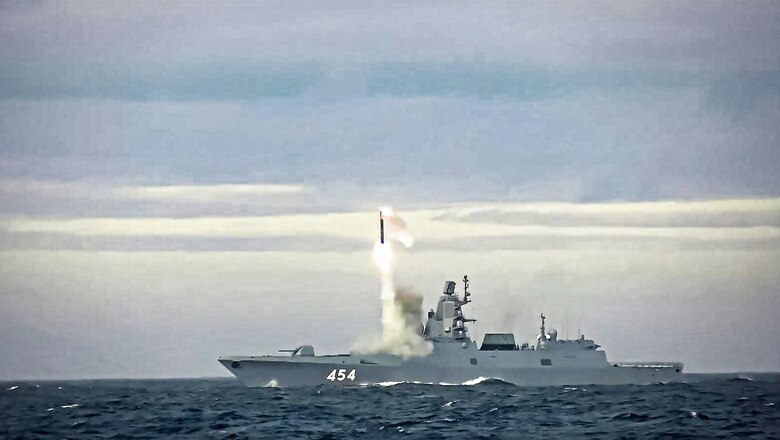
views
The Russian navy on Saturday conducted another test of a prospective hypersonic cruise missile called Zircon, in a demonstration of the military’s long-range strike capability amid the war in Ukraine.
The launch was the latest in a series of tests of Zircon, which is set to enter service later this year. The Defense Ministry said the missile was launched in the Barents Sea, successfully hitting a practice target in the White Sea about 1,000 kilometers (540 nautical miles) away.
As Russia presses on with boosting its military capability amid its action in Ukraine, here is all you need to know about the Zircon launch:
What is a Hypersonic Missile?
Putin has described the use of hypersonic missiles as a family of new “invincible” arms in Russia’s arsenal. As previously explained after the launch of the Kinzhal missile by Moscow, hypersonic missiles travel at Mach 5 or faster (five times the speed of sound). Because of their low trajectory, high speed, and manoeuvrability, hypersonic missiles are difficult to detect by US missile defence satellites and radars.
However, their ability to deliver nuclear weapons may increase a country’s threat, increasing the risk of a nuclear conflict. “This is the first case in the world of the use of hypersonic weapons in combat,” military analyst Vasily Kashin had told AFP after Moscow said it had used for the first time in combat its high-precision Kinzhal, or dagger hypersonic missile in March.
Kashin, head of the Centre for Comprehensive European and International Studies at Moscow’s Higher School of Economics, said that compared to cruise missiles hypersonic weapons were more efficient at destroying underground storage sites. “A hypersonic missile can have higher penetration and destructive power due to its very high speed,” he said. Like the much slower, often subsonic cruise missile, a hypersonic missile is manoeuverable, making it harder to track and defend against.”
What Are the Zircon’s Capabilities?
Russian President Vladimir Putin has said that Zircon is capable of flying at nine times the speed of sound and has a range of 1,000 kilometers (620 miles). Putin has emphasized that its deployment will significantly boost the capability of Russia’s military.
Zircon is intended to arm Russian cruisers, frigates and submarines and could be used against both enemy ships and ground targets. It is one of several hypersonic missiles under development in Russia.
Russian officials have boasted about Zircon’s capability, saying that it’s impossible to intercept with existing anti-missile systems.
Putin, who has sternly warned Western allies against interfering in Ukraine, has warned in the past that Russian warships armed with Zircon would give Russia a capability to strike “decision-making centers” within minutes if deployed in neutral waters.
Why Is Russia So Keen on Hypersonic Missiles?
Russia’s commitment to hypersonic weapons is most likely a response to the US naval technical edge, according to reports. The US Navy plans to maintain a fleet of 12 nuclear-powered aircraft carriers, but Russia only has one and uses a tugboat to assist it if its engine fails, said a report by the EurAsian Times.
But even the most modern American aircraft carriers are thought to be vulnerable to Zircon missiles. Experts claim that even if defence systems detect a Zircon missile at a distance of 100 miles, they will only have one minute to respond.
Unlike pure hypersonic missiles that rely on scramjets, this missile is a hybrid cruise missile and ballistic missile. Experts have warned that it could potentially overload the United States’ Aegis Combat System, the report says.
Read all the Latest Explainers here




















Comments
0 comment